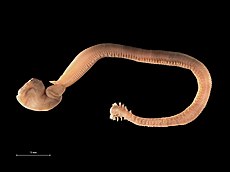Glycera (genus)
| Bloodworms | |
|---|---|
 |
|
| Glycera sp. | |
| Scientific classification | |
| Kingdom: | Animalia |
| Phylum: | Annelida |
| Class: | Polychaeta |
| Order: | Phyllodocida |
| Family: | Glyceridae |
| Genus: |
Glycera Savigny, 1818 |
| Species | |
|
many, see text |
|
many, see text
The genus Glycera is a group of polychaetes (bristle worms) commonly known as bloodworms. They are typically found on the bottom of shallow marine waters, and some species (e.g. the common blood worm, Glycera dibranchiata), are extensively harvested along the Northeastern coast of the United States for use as bait in fishing. Another common species is the tufted gilled bloodworm, G. americana.
Bloodworms have a creamy pink color, as their pale skin allows their red body fluids that contain hemoglobin to show through. This is the origin of the name "bloodworm". At the 'head', bloodworms have four small antennae and small fleshy projections called parapodia running down their bodies. Bloodworms can grow up to 35 centimetres (14 in) in length.
Bloodworms are poor swimmers but good burrowers, living on the sandy or silty bottoms of the intertidal or subtidal regions. Though usually marine, they can tolerate low salt levels in the water, and also poor oxygen levels. Bloodworms and all water worms have adapted to life in the sand and silt for the protection it offers.
Bloodworms are carnivorous. They feed by extending a large proboscis that bears four hollow jaws. The jaws are connected to glands that supply venom which they use to kill their prey, and their bite is painful even to a human. They are preyed on by other worms, by bottom-feeding fish and crustaceans, and by gulls.
Reproduction occurs in midsummer, when the warmer water temperature and lunar cycle among other factors triggers sexually mature worms to transform into a non-feeding stage called the epitoke. With enlarged parapodia, they swim to the surface of the water where both sexes release gametes, and then die.
The first stage in many forms of bloodworm is a zooplanktonic stage followed by the benthic instar where the familiar segmented red larvae develop protected by silk tubes made in the bottom silt. These larvae progress from tiny pale opaque worms to the larger red larvae of 3 to 10 centimeters in length or longer over a period of as short a period as 2 – 3 weeks in optimum conditions.
The animals are unique in that they contain a lot of copper without being poisoned. Their jaws are unusually strong since they too contain the metal in the form of a copper-based chloride biomineral, known as atacamite. And unlike the clamworm (Nereis limbata), whose jaws contain the metal zinc, the copper in the mineral in the jaws of Glycera is actually present in its crystalline form. It is theorized that this copper is used as a catalyst for its poisonous bite.
...
Wikipedia
